Applications of Pathophysiological and Pharmacotherapeutic Concepts in Clinical Decision Making
VerifiedAdded on 2022/12/05
|10
|3000
|119
AI Summary
This article discusses the applications of pathophysiological and pharmacotherapeutic concepts in clinical decision making for a case study of a pregnant woman with allergies. It explores the safe use of medication, principles of quality use of medicine, and the justification of coherent decision-making.
Contribute Materials
Your contribution can guide someone’s learning journey. Share your
documents today.
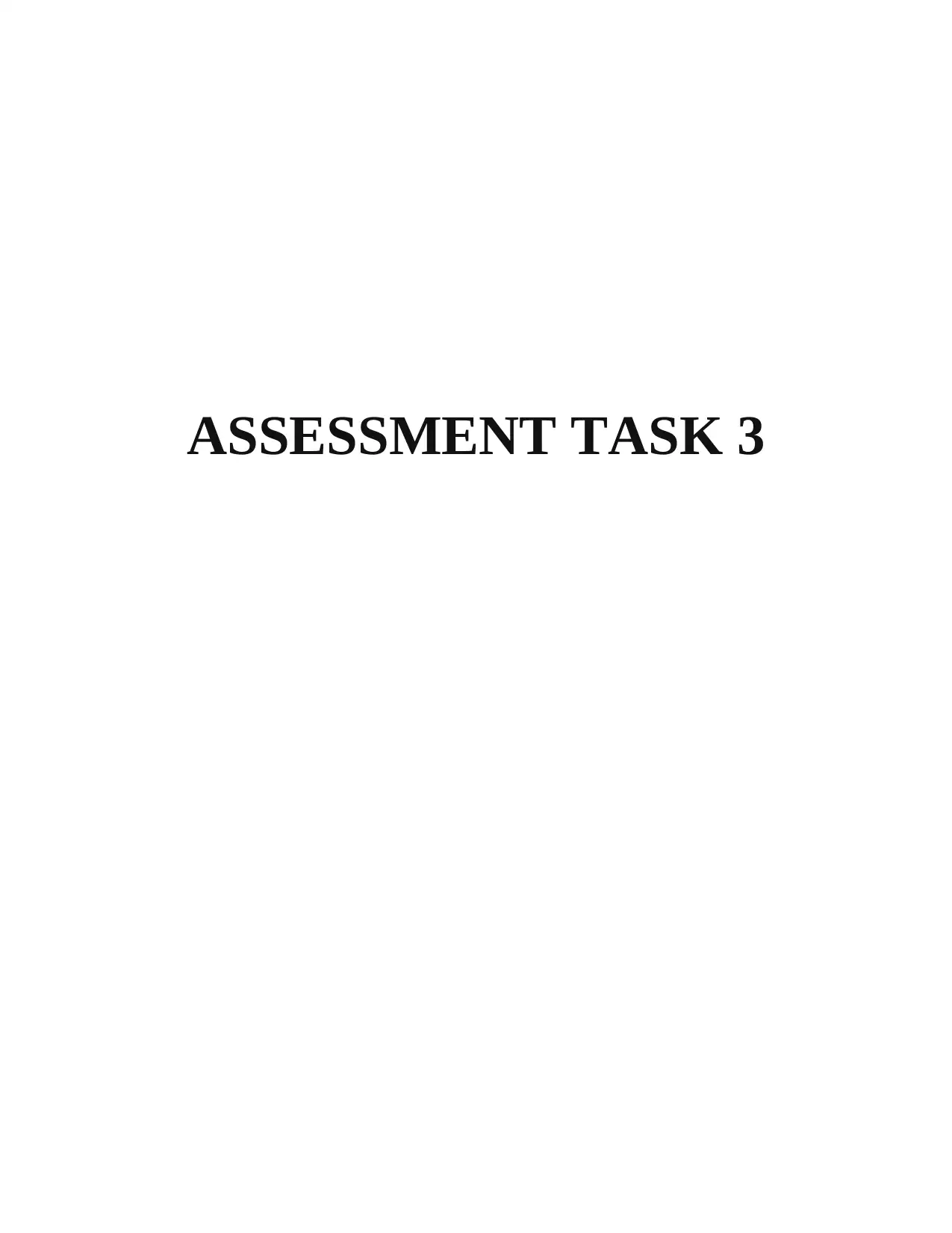
ASSESSMENT TASK 3
Secure Best Marks with AI Grader
Need help grading? Try our AI Grader for instant feedback on your assignments.
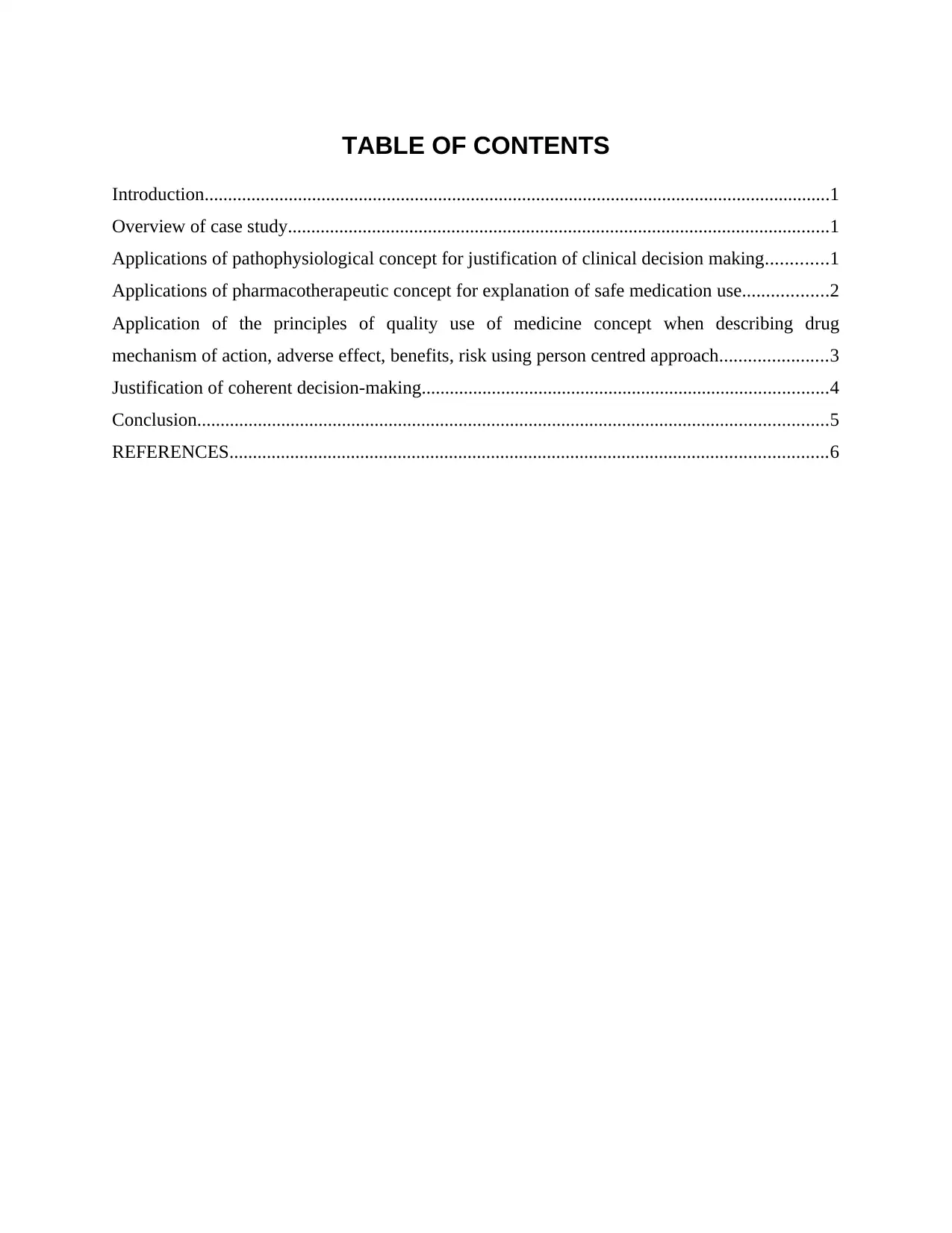
TABLE OF CONTENTS
Introduction......................................................................................................................................1
Overview of case study....................................................................................................................1
Applications of pathophysiological concept for justification of clinical decision making.............1
Applications of pharmacotherapeutic concept for explanation of safe medication use..................2
Application of the principles of quality use of medicine concept when describing drug
mechanism of action, adverse effect, benefits, risk using person centred approach.......................3
Justification of coherent decision-making.......................................................................................4
Conclusion.......................................................................................................................................5
REFERENCES................................................................................................................................6
Introduction......................................................................................................................................1
Overview of case study....................................................................................................................1
Applications of pathophysiological concept for justification of clinical decision making.............1
Applications of pharmacotherapeutic concept for explanation of safe medication use..................2
Application of the principles of quality use of medicine concept when describing drug
mechanism of action, adverse effect, benefits, risk using person centred approach.......................3
Justification of coherent decision-making.......................................................................................4
Conclusion.......................................................................................................................................5
REFERENCES................................................................................................................................6
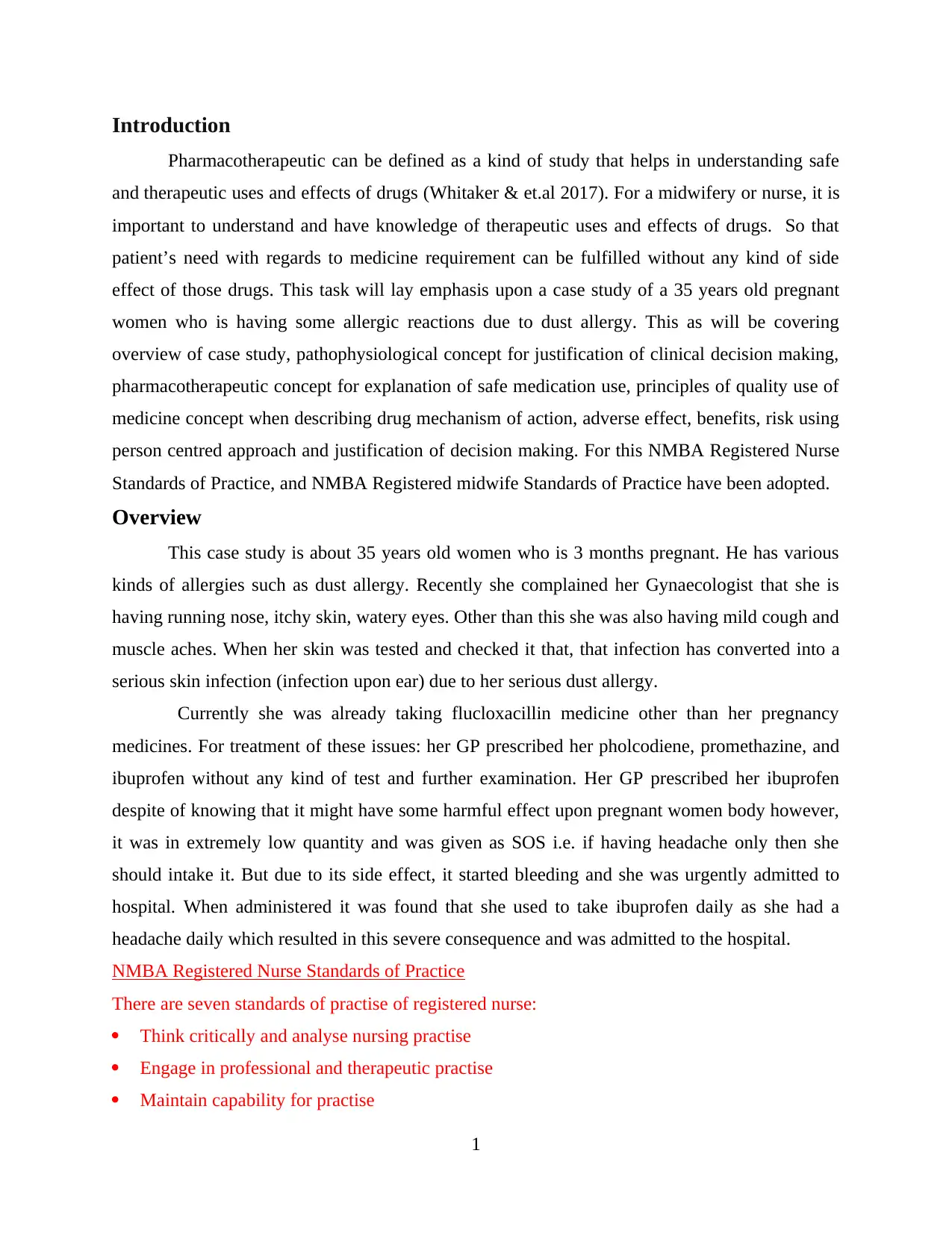
Introduction
Pharmacotherapeutic can be defined as a kind of study that helps in understanding safe
and therapeutic uses and effects of drugs (Whitaker & et.al 2017). For a midwifery or nurse, it is
important to understand and have knowledge of therapeutic uses and effects of drugs. So that
patient’s need with regards to medicine requirement can be fulfilled without any kind of side
effect of those drugs. This task will lay emphasis upon a case study of a 35 years old pregnant
women who is having some allergic reactions due to dust allergy. This as will be covering
overview of case study, pathophysiological concept for justification of clinical decision making,
pharmacotherapeutic concept for explanation of safe medication use, principles of quality use of
medicine concept when describing drug mechanism of action, adverse effect, benefits, risk using
person centred approach and justification of decision making. For this NMBA Registered Nurse
Standards of Practice, and NMBA Registered midwife Standards of Practice have been adopted.
Overview
This case study is about 35 years old women who is 3 months pregnant. He has various
kinds of allergies such as dust allergy. Recently she complained her Gynaecologist that she is
having running nose, itchy skin, watery eyes. Other than this she was also having mild cough and
muscle aches. When her skin was tested and checked it that, that infection has converted into a
serious skin infection (infection upon ear) due to her serious dust allergy.
Currently she was already taking flucloxacillin medicine other than her pregnancy
medicines. For treatment of these issues: her GP prescribed her pholcodiene, promethazine, and
ibuprofen without any kind of test and further examination. Her GP prescribed her ibuprofen
despite of knowing that it might have some harmful effect upon pregnant women body however,
it was in extremely low quantity and was given as SOS i.e. if having headache only then she
should intake it. But due to its side effect, it started bleeding and she was urgently admitted to
hospital. When administered it was found that she used to take ibuprofen daily as she had a
headache daily which resulted in this severe consequence and was admitted to the hospital.
NMBA Registered Nurse Standards of Practice
There are seven standards of practise of registered nurse:
Think critically and analyse nursing practise
Engage in professional and therapeutic practise
Maintain capability for practise
1
Pharmacotherapeutic can be defined as a kind of study that helps in understanding safe
and therapeutic uses and effects of drugs (Whitaker & et.al 2017). For a midwifery or nurse, it is
important to understand and have knowledge of therapeutic uses and effects of drugs. So that
patient’s need with regards to medicine requirement can be fulfilled without any kind of side
effect of those drugs. This task will lay emphasis upon a case study of a 35 years old pregnant
women who is having some allergic reactions due to dust allergy. This as will be covering
overview of case study, pathophysiological concept for justification of clinical decision making,
pharmacotherapeutic concept for explanation of safe medication use, principles of quality use of
medicine concept when describing drug mechanism of action, adverse effect, benefits, risk using
person centred approach and justification of decision making. For this NMBA Registered Nurse
Standards of Practice, and NMBA Registered midwife Standards of Practice have been adopted.
Overview
This case study is about 35 years old women who is 3 months pregnant. He has various
kinds of allergies such as dust allergy. Recently she complained her Gynaecologist that she is
having running nose, itchy skin, watery eyes. Other than this she was also having mild cough and
muscle aches. When her skin was tested and checked it that, that infection has converted into a
serious skin infection (infection upon ear) due to her serious dust allergy.
Currently she was already taking flucloxacillin medicine other than her pregnancy
medicines. For treatment of these issues: her GP prescribed her pholcodiene, promethazine, and
ibuprofen without any kind of test and further examination. Her GP prescribed her ibuprofen
despite of knowing that it might have some harmful effect upon pregnant women body however,
it was in extremely low quantity and was given as SOS i.e. if having headache only then she
should intake it. But due to its side effect, it started bleeding and she was urgently admitted to
hospital. When administered it was found that she used to take ibuprofen daily as she had a
headache daily which resulted in this severe consequence and was admitted to the hospital.
NMBA Registered Nurse Standards of Practice
There are seven standards of practise of registered nurse:
Think critically and analyse nursing practise
Engage in professional and therapeutic practise
Maintain capability for practise
1
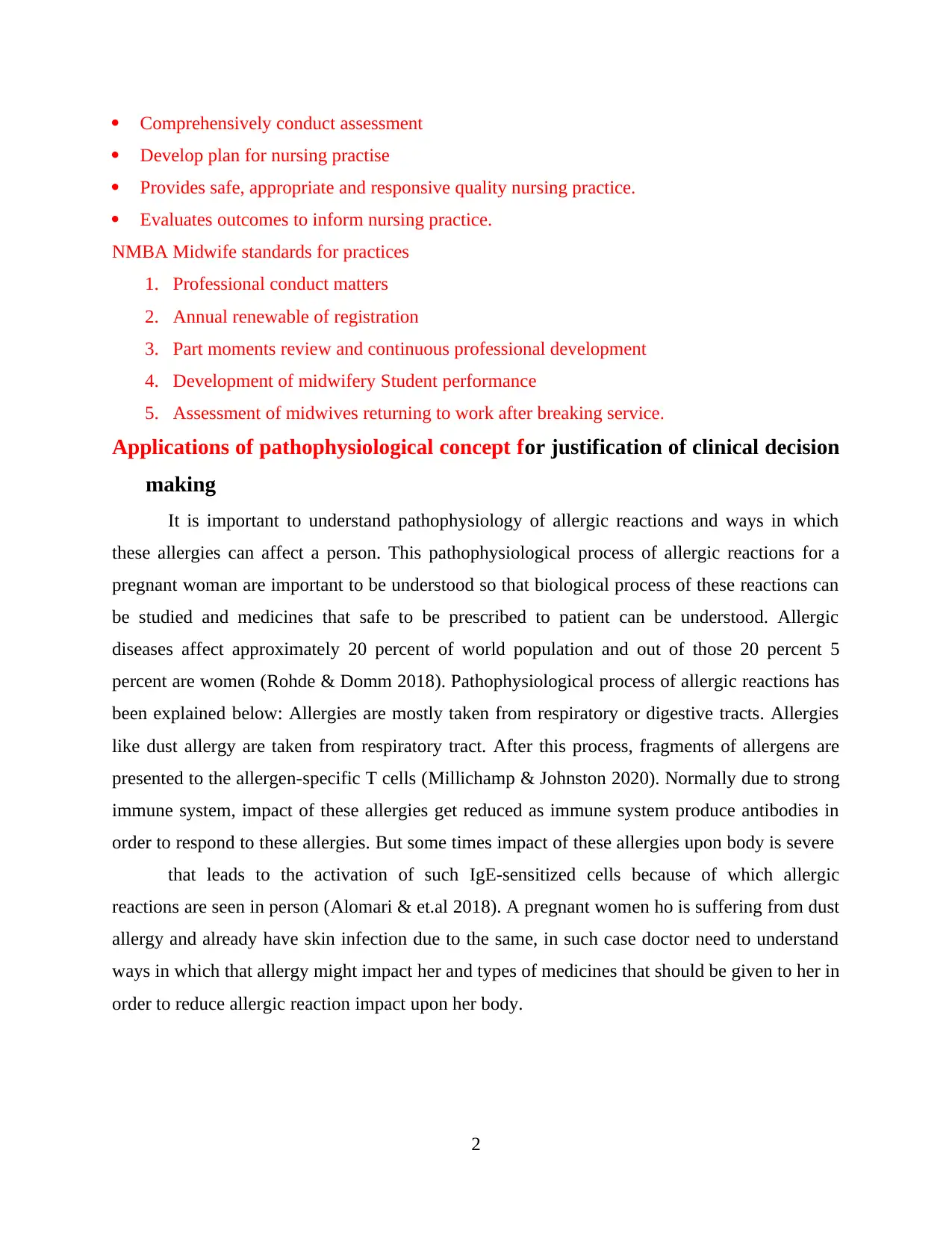
Comprehensively conduct assessment
Develop plan for nursing practise
Provides safe, appropriate and responsive quality nursing practice.
Evaluates outcomes to inform nursing practice.
NMBA Midwife standards for practices
1. Professional conduct matters
2. Annual renewable of registration
3. Part moments review and continuous professional development
4. Development of midwifery Student performance
5. Assessment of midwives returning to work after breaking service.
Applications of pathophysiological concept for justification of clinical decision
making
It is important to understand pathophysiology of allergic reactions and ways in which
these allergies can affect a person. This pathophysiological process of allergic reactions for a
pregnant woman are important to be understood so that biological process of these reactions can
be studied and medicines that safe to be prescribed to patient can be understood. Allergic
diseases affect approximately 20 percent of world population and out of those 20 percent 5
percent are women (Rohde & Domm 2018). Pathophysiological process of allergic reactions has
been explained below: Allergies are mostly taken from respiratory or digestive tracts. Allergies
like dust allergy are taken from respiratory tract. After this process, fragments of allergens are
presented to the allergen-specific T cells (Millichamp & Johnston 2020). Normally due to strong
immune system, impact of these allergies get reduced as immune system produce antibodies in
order to respond to these allergies. But some times impact of these allergies upon body is severe
that leads to the activation of such IgE-sensitized cells because of which allergic
reactions are seen in person (Alomari & et.al 2018). A pregnant women ho is suffering from dust
allergy and already have skin infection due to the same, in such case doctor need to understand
ways in which that allergy might impact her and types of medicines that should be given to her in
order to reduce allergic reaction impact upon her body.
2
Develop plan for nursing practise
Provides safe, appropriate and responsive quality nursing practice.
Evaluates outcomes to inform nursing practice.
NMBA Midwife standards for practices
1. Professional conduct matters
2. Annual renewable of registration
3. Part moments review and continuous professional development
4. Development of midwifery Student performance
5. Assessment of midwives returning to work after breaking service.
Applications of pathophysiological concept for justification of clinical decision
making
It is important to understand pathophysiology of allergic reactions and ways in which
these allergies can affect a person. This pathophysiological process of allergic reactions for a
pregnant woman are important to be understood so that biological process of these reactions can
be studied and medicines that safe to be prescribed to patient can be understood. Allergic
diseases affect approximately 20 percent of world population and out of those 20 percent 5
percent are women (Rohde & Domm 2018). Pathophysiological process of allergic reactions has
been explained below: Allergies are mostly taken from respiratory or digestive tracts. Allergies
like dust allergy are taken from respiratory tract. After this process, fragments of allergens are
presented to the allergen-specific T cells (Millichamp & Johnston 2020). Normally due to strong
immune system, impact of these allergies get reduced as immune system produce antibodies in
order to respond to these allergies. But some times impact of these allergies upon body is severe
that leads to the activation of such IgE-sensitized cells because of which allergic
reactions are seen in person (Alomari & et.al 2018). A pregnant women ho is suffering from dust
allergy and already have skin infection due to the same, in such case doctor need to understand
ways in which that allergy might impact her and types of medicines that should be given to her in
order to reduce allergic reaction impact upon her body.
2
Secure Best Marks with AI Grader
Need help grading? Try our AI Grader for instant feedback on your assignments.
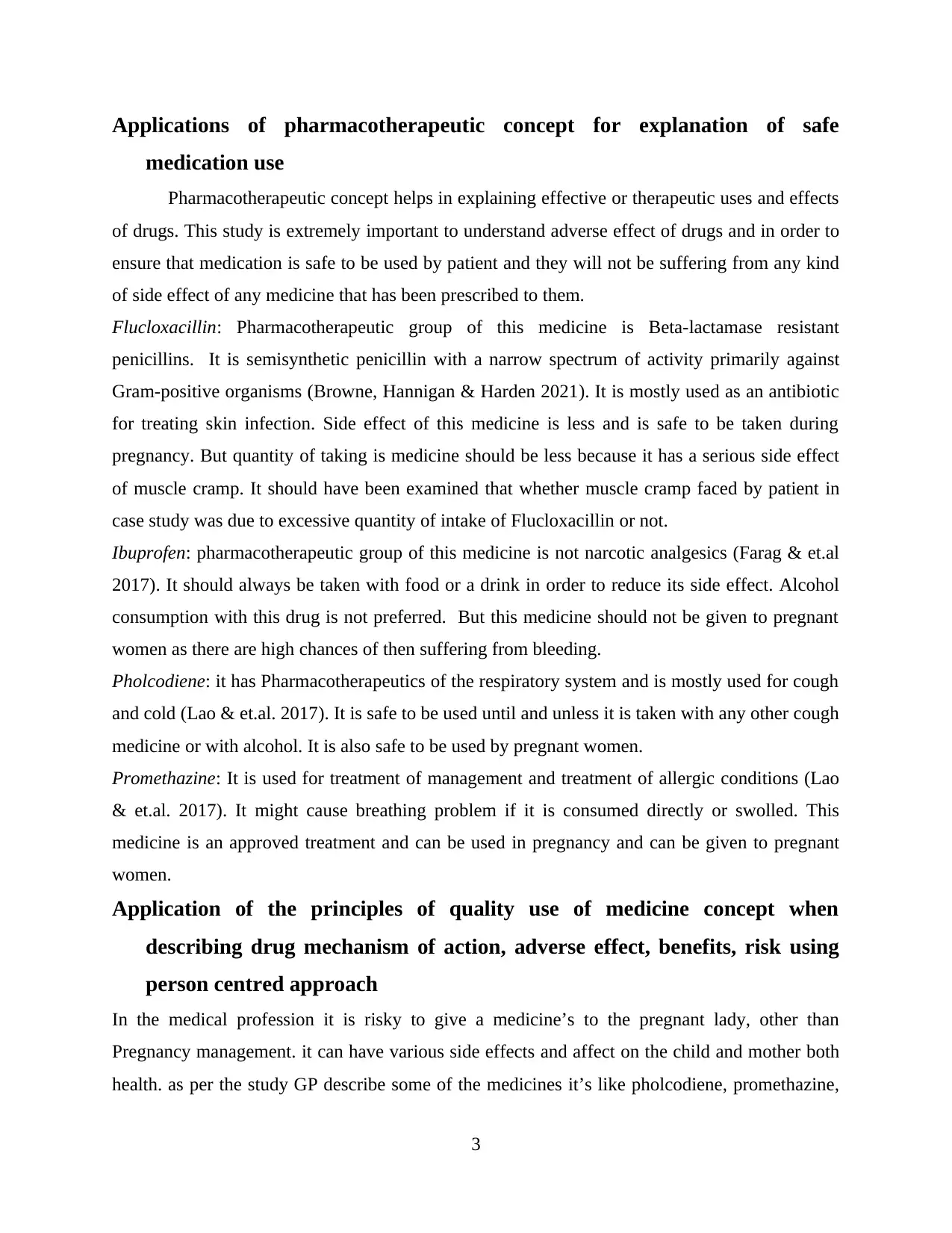
Applications of pharmacotherapeutic concept for explanation of safe
medication use
Pharmacotherapeutic concept helps in explaining effective or therapeutic uses and effects
of drugs. This study is extremely important to understand adverse effect of drugs and in order to
ensure that medication is safe to be used by patient and they will not be suffering from any kind
of side effect of any medicine that has been prescribed to them.
Flucloxacillin: Pharmacotherapeutic group of this medicine is Beta-lactamase resistant
penicillins. It is semisynthetic penicillin with a narrow spectrum of activity primarily against
Gram-positive organisms (Browne, Hannigan & Harden 2021). It is mostly used as an antibiotic
for treating skin infection. Side effect of this medicine is less and is safe to be taken during
pregnancy. But quantity of taking is medicine should be less because it has a serious side effect
of muscle cramp. It should have been examined that whether muscle cramp faced by patient in
case study was due to excessive quantity of intake of Flucloxacillin or not.
Ibuprofen: pharmacotherapeutic group of this medicine is not narcotic analgesics (Farag & et.al
2017). It should always be taken with food or a drink in order to reduce its side effect. Alcohol
consumption with this drug is not preferred. But this medicine should not be given to pregnant
women as there are high chances of then suffering from bleeding.
Pholcodiene: it has Pharmacotherapeutics of the respiratory system and is mostly used for cough
and cold (Lao & et.al. 2017). It is safe to be used until and unless it is taken with any other cough
medicine or with alcohol. It is also safe to be used by pregnant women.
Promethazine: It is used for treatment of management and treatment of allergic conditions (Lao
& et.al. 2017). It might cause breathing problem if it is consumed directly or swolled. This
medicine is an approved treatment and can be used in pregnancy and can be given to pregnant
women.
Application of the principles of quality use of medicine concept when
describing drug mechanism of action, adverse effect, benefits, risk using
person centred approach
In the medical profession it is risky to give a medicine’s to the pregnant lady, other than
Pregnancy management. it can have various side effects and affect on the child and mother both
health. as per the study GP describe some of the medicines it’s like pholcodiene, promethazine,
3
medication use
Pharmacotherapeutic concept helps in explaining effective or therapeutic uses and effects
of drugs. This study is extremely important to understand adverse effect of drugs and in order to
ensure that medication is safe to be used by patient and they will not be suffering from any kind
of side effect of any medicine that has been prescribed to them.
Flucloxacillin: Pharmacotherapeutic group of this medicine is Beta-lactamase resistant
penicillins. It is semisynthetic penicillin with a narrow spectrum of activity primarily against
Gram-positive organisms (Browne, Hannigan & Harden 2021). It is mostly used as an antibiotic
for treating skin infection. Side effect of this medicine is less and is safe to be taken during
pregnancy. But quantity of taking is medicine should be less because it has a serious side effect
of muscle cramp. It should have been examined that whether muscle cramp faced by patient in
case study was due to excessive quantity of intake of Flucloxacillin or not.
Ibuprofen: pharmacotherapeutic group of this medicine is not narcotic analgesics (Farag & et.al
2017). It should always be taken with food or a drink in order to reduce its side effect. Alcohol
consumption with this drug is not preferred. But this medicine should not be given to pregnant
women as there are high chances of then suffering from bleeding.
Pholcodiene: it has Pharmacotherapeutics of the respiratory system and is mostly used for cough
and cold (Lao & et.al. 2017). It is safe to be used until and unless it is taken with any other cough
medicine or with alcohol. It is also safe to be used by pregnant women.
Promethazine: It is used for treatment of management and treatment of allergic conditions (Lao
& et.al. 2017). It might cause breathing problem if it is consumed directly or swolled. This
medicine is an approved treatment and can be used in pregnancy and can be given to pregnant
women.
Application of the principles of quality use of medicine concept when
describing drug mechanism of action, adverse effect, benefits, risk using
person centred approach
In the medical profession it is risky to give a medicine’s to the pregnant lady, other than
Pregnancy management. it can have various side effects and affect on the child and mother both
health. as per the study GP describe some of the medicines it’s like pholcodiene, promethazine,
3
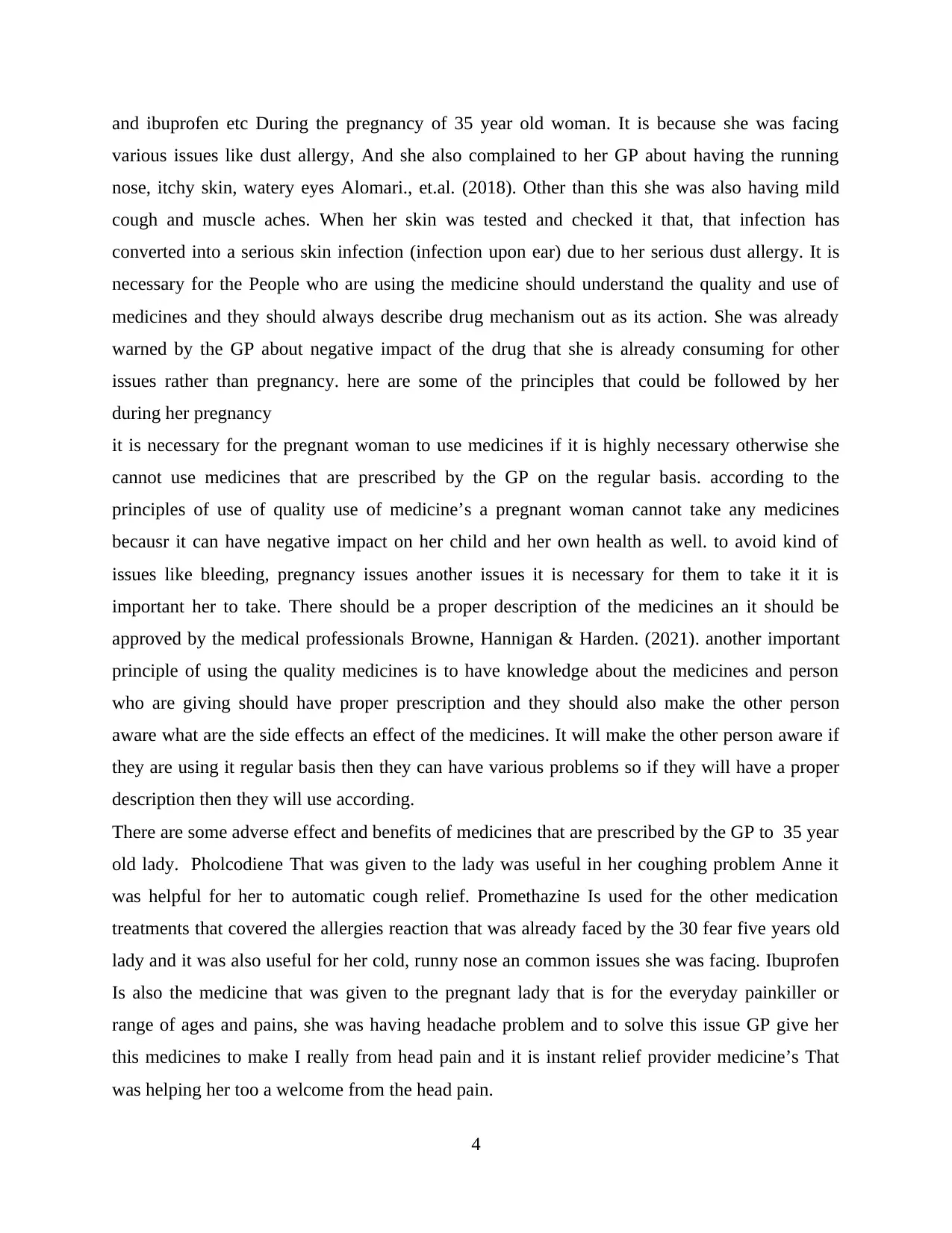
and ibuprofen etc During the pregnancy of 35 year old woman. It is because she was facing
various issues like dust allergy, And she also complained to her GP about having the running
nose, itchy skin, watery eyes Alomari., et.al. (2018). Other than this she was also having mild
cough and muscle aches. When her skin was tested and checked it that, that infection has
converted into a serious skin infection (infection upon ear) due to her serious dust allergy. It is
necessary for the People who are using the medicine should understand the quality and use of
medicines and they should always describe drug mechanism out as its action. She was already
warned by the GP about negative impact of the drug that she is already consuming for other
issues rather than pregnancy. here are some of the principles that could be followed by her
during her pregnancy
it is necessary for the pregnant woman to use medicines if it is highly necessary otherwise she
cannot use medicines that are prescribed by the GP on the regular basis. according to the
principles of use of quality use of medicine’s a pregnant woman cannot take any medicines
becausr it can have negative impact on her child and her own health as well. to avoid kind of
issues like bleeding, pregnancy issues another issues it is necessary for them to take it it is
important her to take. There should be a proper description of the medicines an it should be
approved by the medical professionals Browne, Hannigan & Harden. (2021). another important
principle of using the quality medicines is to have knowledge about the medicines and person
who are giving should have proper prescription and they should also make the other person
aware what are the side effects an effect of the medicines. It will make the other person aware if
they are using it regular basis then they can have various problems so if they will have a proper
description then they will use according.
There are some adverse effect and benefits of medicines that are prescribed by the GP to 35 year
old lady. Pholcodiene That was given to the lady was useful in her coughing problem Anne it
was helpful for her to automatic cough relief. Promethazine Is used for the other medication
treatments that covered the allergies reaction that was already faced by the 30 fear five years old
lady and it was also useful for her cold, runny nose an common issues she was facing. Ibuprofen
Is also the medicine that was given to the pregnant lady that is for the everyday painkiller or
range of ages and pains, she was having headache problem and to solve this issue GP give her
this medicines to make I really from head pain and it is instant relief provider medicine’s That
was helping her too a welcome from the head pain.
4
various issues like dust allergy, And she also complained to her GP about having the running
nose, itchy skin, watery eyes Alomari., et.al. (2018). Other than this she was also having mild
cough and muscle aches. When her skin was tested and checked it that, that infection has
converted into a serious skin infection (infection upon ear) due to her serious dust allergy. It is
necessary for the People who are using the medicine should understand the quality and use of
medicines and they should always describe drug mechanism out as its action. She was already
warned by the GP about negative impact of the drug that she is already consuming for other
issues rather than pregnancy. here are some of the principles that could be followed by her
during her pregnancy
it is necessary for the pregnant woman to use medicines if it is highly necessary otherwise she
cannot use medicines that are prescribed by the GP on the regular basis. according to the
principles of use of quality use of medicine’s a pregnant woman cannot take any medicines
becausr it can have negative impact on her child and her own health as well. to avoid kind of
issues like bleeding, pregnancy issues another issues it is necessary for them to take it it is
important her to take. There should be a proper description of the medicines an it should be
approved by the medical professionals Browne, Hannigan & Harden. (2021). another important
principle of using the quality medicines is to have knowledge about the medicines and person
who are giving should have proper prescription and they should also make the other person
aware what are the side effects an effect of the medicines. It will make the other person aware if
they are using it regular basis then they can have various problems so if they will have a proper
description then they will use according.
There are some adverse effect and benefits of medicines that are prescribed by the GP to 35 year
old lady. Pholcodiene That was given to the lady was useful in her coughing problem Anne it
was helpful for her to automatic cough relief. Promethazine Is used for the other medication
treatments that covered the allergies reaction that was already faced by the 30 fear five years old
lady and it was also useful for her cold, runny nose an common issues she was facing. Ibuprofen
Is also the medicine that was given to the pregnant lady that is for the everyday painkiller or
range of ages and pains, she was having headache problem and to solve this issue GP give her
this medicines to make I really from head pain and it is instant relief provider medicine’s That
was helping her too a welcome from the head pain.
4
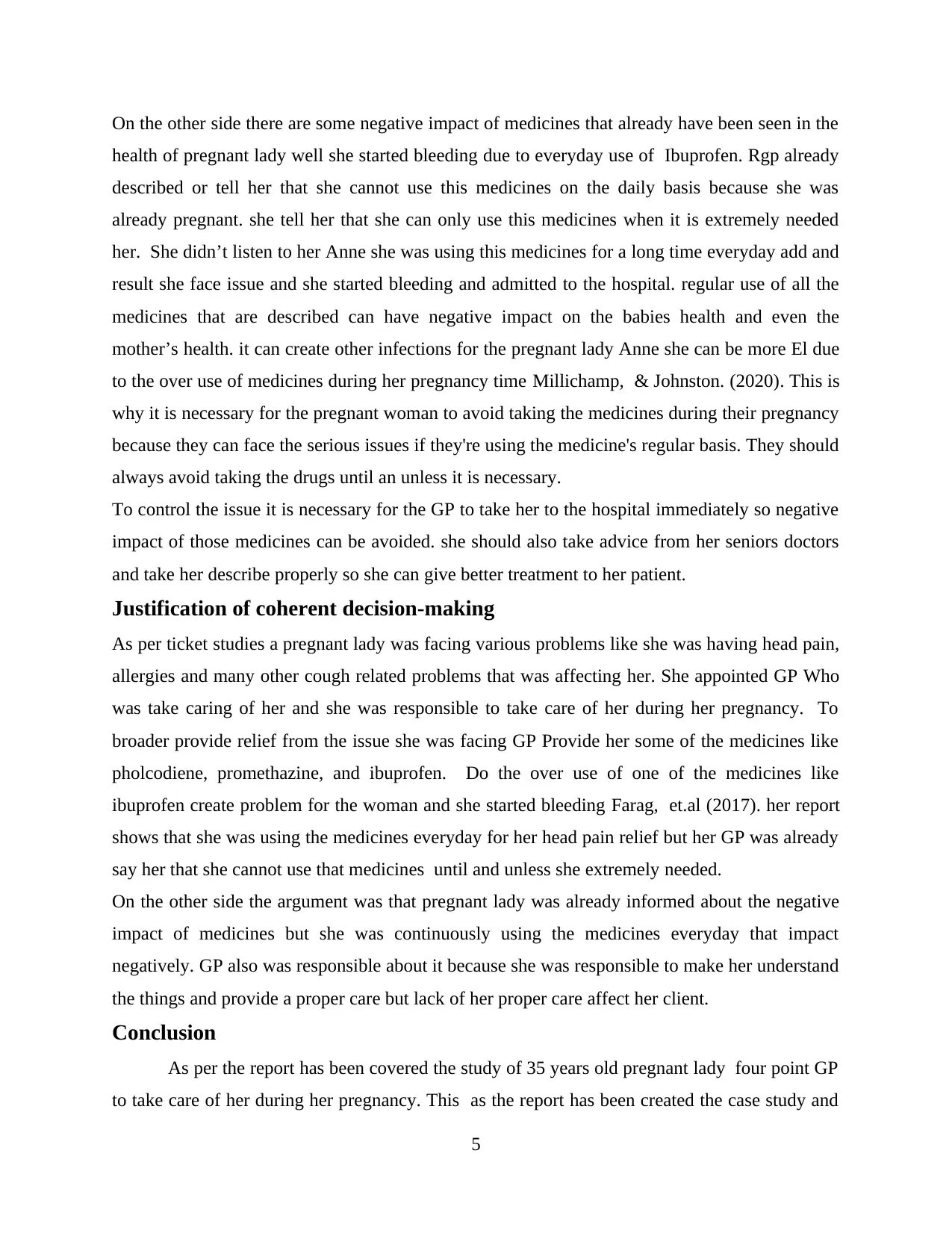
On the other side there are some negative impact of medicines that already have been seen in the
health of pregnant lady well she started bleeding due to everyday use of Ibuprofen. Rgp already
described or tell her that she cannot use this medicines on the daily basis because she was
already pregnant. she tell her that she can only use this medicines when it is extremely needed
her. She didn’t listen to her Anne she was using this medicines for a long time everyday add and
result she face issue and she started bleeding and admitted to the hospital. regular use of all the
medicines that are described can have negative impact on the babies health and even the
mother’s health. it can create other infections for the pregnant lady Anne she can be more El due
to the over use of medicines during her pregnancy time Millichamp, & Johnston. (2020). This is
why it is necessary for the pregnant woman to avoid taking the medicines during their pregnancy
because they can face the serious issues if they're using the medicine's regular basis. They should
always avoid taking the drugs until an unless it is necessary.
To control the issue it is necessary for the GP to take her to the hospital immediately so negative
impact of those medicines can be avoided. she should also take advice from her seniors doctors
and take her describe properly so she can give better treatment to her patient.
Justification of coherent decision-making
As per ticket studies a pregnant lady was facing various problems like she was having head pain,
allergies and many other cough related problems that was affecting her. She appointed GP Who
was take caring of her and she was responsible to take care of her during her pregnancy. To
broader provide relief from the issue she was facing GP Provide her some of the medicines like
pholcodiene, promethazine, and ibuprofen. Do the over use of one of the medicines like
ibuprofen create problem for the woman and she started bleeding Farag, et.al (2017). her report
shows that she was using the medicines everyday for her head pain relief but her GP was already
say her that she cannot use that medicines until and unless she extremely needed.
On the other side the argument was that pregnant lady was already informed about the negative
impact of medicines but she was continuously using the medicines everyday that impact
negatively. GP also was responsible about it because she was responsible to make her understand
the things and provide a proper care but lack of her proper care affect her client.
Conclusion
As per the report has been covered the study of 35 years old pregnant lady four point GP
to take care of her during her pregnancy. This as the report has been created the case study and
5
health of pregnant lady well she started bleeding due to everyday use of Ibuprofen. Rgp already
described or tell her that she cannot use this medicines on the daily basis because she was
already pregnant. she tell her that she can only use this medicines when it is extremely needed
her. She didn’t listen to her Anne she was using this medicines for a long time everyday add and
result she face issue and she started bleeding and admitted to the hospital. regular use of all the
medicines that are described can have negative impact on the babies health and even the
mother’s health. it can create other infections for the pregnant lady Anne she can be more El due
to the over use of medicines during her pregnancy time Millichamp, & Johnston. (2020). This is
why it is necessary for the pregnant woman to avoid taking the medicines during their pregnancy
because they can face the serious issues if they're using the medicine's regular basis. They should
always avoid taking the drugs until an unless it is necessary.
To control the issue it is necessary for the GP to take her to the hospital immediately so negative
impact of those medicines can be avoided. she should also take advice from her seniors doctors
and take her describe properly so she can give better treatment to her patient.
Justification of coherent decision-making
As per ticket studies a pregnant lady was facing various problems like she was having head pain,
allergies and many other cough related problems that was affecting her. She appointed GP Who
was take caring of her and she was responsible to take care of her during her pregnancy. To
broader provide relief from the issue she was facing GP Provide her some of the medicines like
pholcodiene, promethazine, and ibuprofen. Do the over use of one of the medicines like
ibuprofen create problem for the woman and she started bleeding Farag, et.al (2017). her report
shows that she was using the medicines everyday for her head pain relief but her GP was already
say her that she cannot use that medicines until and unless she extremely needed.
On the other side the argument was that pregnant lady was already informed about the negative
impact of medicines but she was continuously using the medicines everyday that impact
negatively. GP also was responsible about it because she was responsible to make her understand
the things and provide a proper care but lack of her proper care affect her client.
Conclusion
As per the report has been covered the study of 35 years old pregnant lady four point GP
to take care of her during her pregnancy. This as the report has been created the case study and
5
Paraphrase This Document
Need a fresh take? Get an instant paraphrase of this document with our AI Paraphraser

explain pathophysiological concept for justification of clinical decision making. It also has been
provided the application of concept for justification of clinical decision making. It also has been
covered principles of quality use of medicine concept when describing drug mechanism of
action, adverse effect, benefits, risk using person centred approach. In the end of this report has
been concluded the argument off coherent decision-making.
6
provided the application of concept for justification of clinical decision making. It also has been
covered principles of quality use of medicine concept when describing drug mechanism of
action, adverse effect, benefits, risk using person centred approach. In the end of this report has
been concluded the argument off coherent decision-making.
6
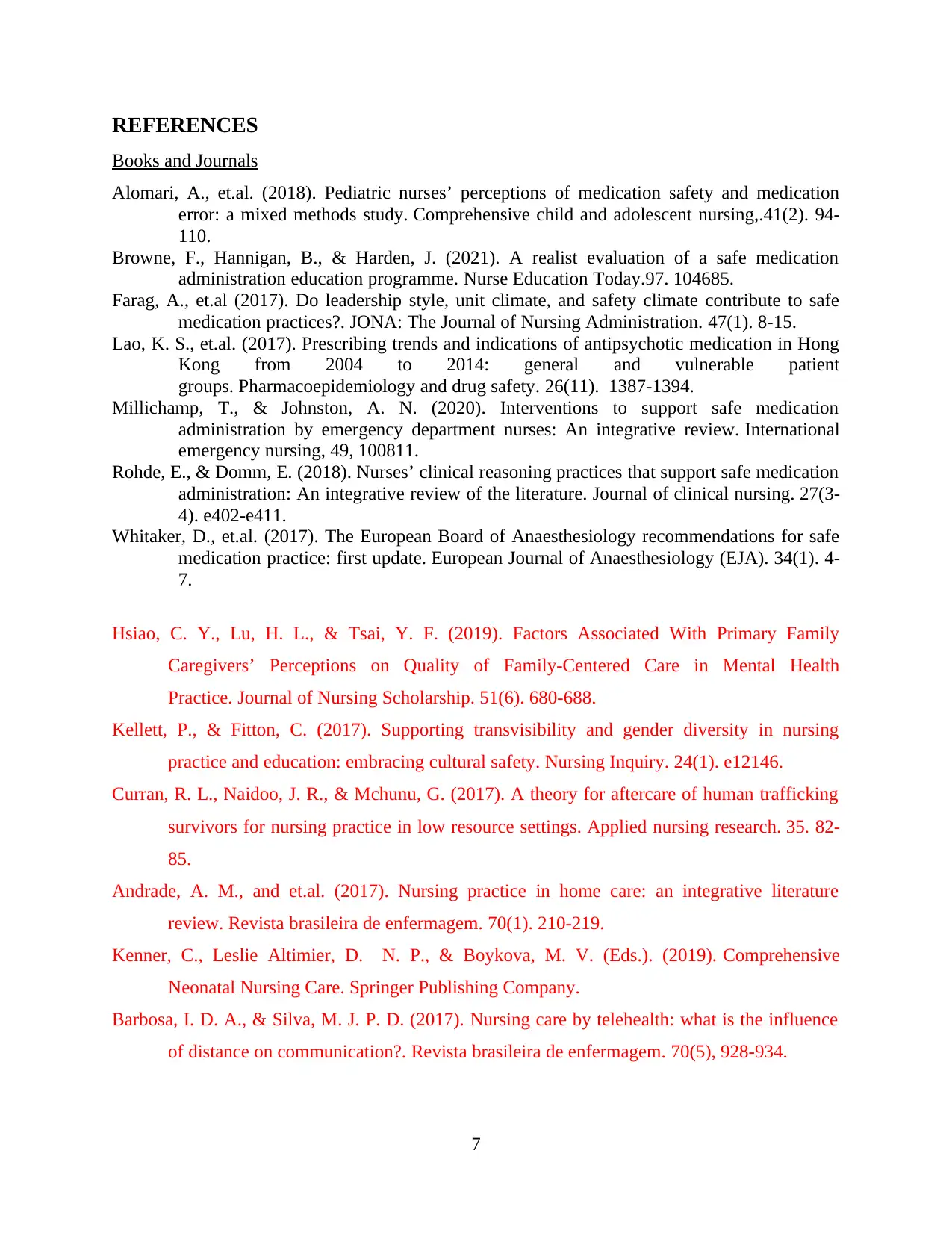
REFERENCES
Books and Journals
Alomari, A., et.al. (2018). Pediatric nurses’ perceptions of medication safety and medication
error: a mixed methods study. Comprehensive child and adolescent nursing,.41(2). 94-
110.
Browne, F., Hannigan, B., & Harden, J. (2021). A realist evaluation of a safe medication
administration education programme. Nurse Education Today.97. 104685.
Farag, A., et.al (2017). Do leadership style, unit climate, and safety climate contribute to safe
medication practices?. JONA: The Journal of Nursing Administration. 47(1). 8-15.
Lao, K. S., et.al. (2017). Prescribing trends and indications of antipsychotic medication in Hong
Kong from 2004 to 2014: general and vulnerable patient
groups. Pharmacoepidemiology and drug safety. 26(11). 1387-1394.
Millichamp, T., & Johnston, A. N. (2020). Interventions to support safe medication
administration by emergency department nurses: An integrative review. International
emergency nursing, 49, 100811.
Rohde, E., & Domm, E. (2018). Nurses’ clinical reasoning practices that support safe medication
administration: An integrative review of the literature. Journal of clinical nursing. 27(3-
4). e402-e411.
Whitaker, D., et.al. (2017). The European Board of Anaesthesiology recommendations for safe
medication practice: first update. European Journal of Anaesthesiology (EJA). 34(1). 4-
7.
Hsiao, C. Y., Lu, H. L., & Tsai, Y. F. (2019). Factors Associated With Primary Family
Caregivers’ Perceptions on Quality of Family‐Centered Care in Mental Health
Practice. Journal of Nursing Scholarship. 51(6). 680-688.
Kellett, P., & Fitton, C. (2017). Supporting transvisibility and gender diversity in nursing
practice and education: embracing cultural safety. Nursing Inquiry. 24(1). e12146.
Curran, R. L., Naidoo, J. R., & Mchunu, G. (2017). A theory for aftercare of human trafficking
survivors for nursing practice in low resource settings. Applied nursing research. 35. 82-
85.
Andrade, A. M., and et.al. (2017). Nursing practice in home care: an integrative literature
review. Revista brasileira de enfermagem. 70(1). 210-219.
Kenner, C., Leslie Altimier, D. N. P., & Boykova, M. V. (Eds.). (2019). Comprehensive
Neonatal Nursing Care. Springer Publishing Company.
Barbosa, I. D. A., & Silva, M. J. P. D. (2017). Nursing care by telehealth: what is the influence
of distance on communication?. Revista brasileira de enfermagem. 70(5), 928-934.
7
Books and Journals
Alomari, A., et.al. (2018). Pediatric nurses’ perceptions of medication safety and medication
error: a mixed methods study. Comprehensive child and adolescent nursing,.41(2). 94-
110.
Browne, F., Hannigan, B., & Harden, J. (2021). A realist evaluation of a safe medication
administration education programme. Nurse Education Today.97. 104685.
Farag, A., et.al (2017). Do leadership style, unit climate, and safety climate contribute to safe
medication practices?. JONA: The Journal of Nursing Administration. 47(1). 8-15.
Lao, K. S., et.al. (2017). Prescribing trends and indications of antipsychotic medication in Hong
Kong from 2004 to 2014: general and vulnerable patient
groups. Pharmacoepidemiology and drug safety. 26(11). 1387-1394.
Millichamp, T., & Johnston, A. N. (2020). Interventions to support safe medication
administration by emergency department nurses: An integrative review. International
emergency nursing, 49, 100811.
Rohde, E., & Domm, E. (2018). Nurses’ clinical reasoning practices that support safe medication
administration: An integrative review of the literature. Journal of clinical nursing. 27(3-
4). e402-e411.
Whitaker, D., et.al. (2017). The European Board of Anaesthesiology recommendations for safe
medication practice: first update. European Journal of Anaesthesiology (EJA). 34(1). 4-
7.
Hsiao, C. Y., Lu, H. L., & Tsai, Y. F. (2019). Factors Associated With Primary Family
Caregivers’ Perceptions on Quality of Family‐Centered Care in Mental Health
Practice. Journal of Nursing Scholarship. 51(6). 680-688.
Kellett, P., & Fitton, C. (2017). Supporting transvisibility and gender diversity in nursing
practice and education: embracing cultural safety. Nursing Inquiry. 24(1). e12146.
Curran, R. L., Naidoo, J. R., & Mchunu, G. (2017). A theory for aftercare of human trafficking
survivors for nursing practice in low resource settings. Applied nursing research. 35. 82-
85.
Andrade, A. M., and et.al. (2017). Nursing practice in home care: an integrative literature
review. Revista brasileira de enfermagem. 70(1). 210-219.
Kenner, C., Leslie Altimier, D. N. P., & Boykova, M. V. (Eds.). (2019). Comprehensive
Neonatal Nursing Care. Springer Publishing Company.
Barbosa, I. D. A., & Silva, M. J. P. D. (2017). Nursing care by telehealth: what is the influence
of distance on communication?. Revista brasileira de enfermagem. 70(5), 928-934.
7

Younas, A., & Quennell, S. (2019). Usefulness of nursing theory‐guided practice: an integrative
review. Scandinavian journal of caring sciences, 33(3), 540-55
Younas, A. (2017). A foundational analysis of dorothea orem’s self-care theory and evaluation of
its significance for nursing practice and research. Creative Nursing. 23(1), 13-23.
8
review. Scandinavian journal of caring sciences, 33(3), 540-55
Younas, A. (2017). A foundational analysis of dorothea orem’s self-care theory and evaluation of
its significance for nursing practice and research. Creative Nursing. 23(1), 13-23.
8
1 out of 10
Your All-in-One AI-Powered Toolkit for Academic Success.
+13062052269
info@desklib.com
Available 24*7 on WhatsApp / Email
![[object Object]](/_next/static/media/star-bottom.7253800d.svg)
Unlock your academic potential
© 2024 | Zucol Services PVT LTD | All rights reserved.

